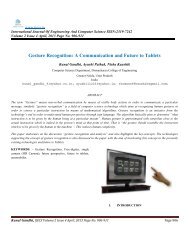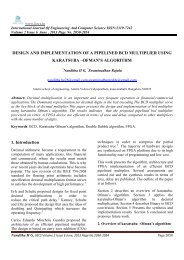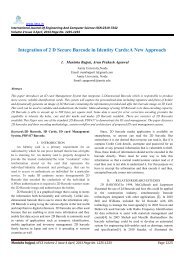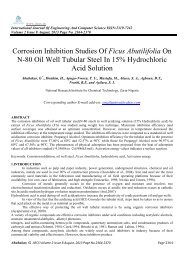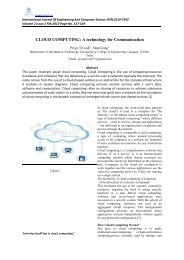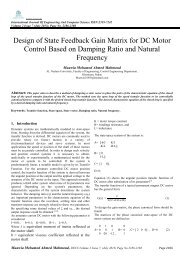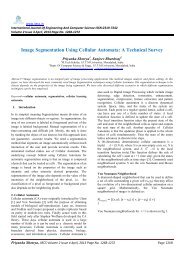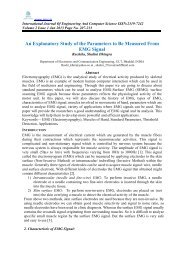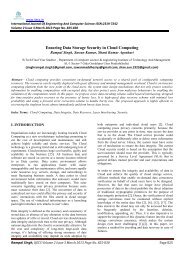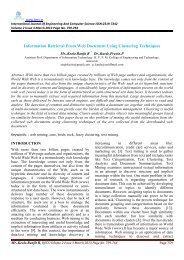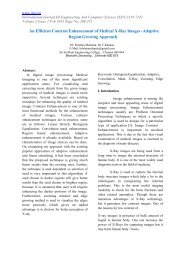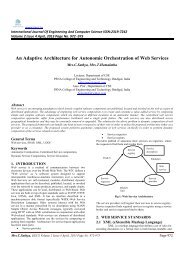Numerical Integration Over Polygonal Domains using Convex ... - Ijecs
Numerical Integration Over Polygonal Domains using Convex ... - Ijecs
Numerical Integration Over Polygonal Domains using Convex ... - Ijecs
Create successful ePaper yourself
Turn your PDF publications into a flip-book with our unique Google optimized e-Paper software.
4 Explicit forms of the Jacobians<br />
We have shown in the previous section that the quadrilaterals Q e in Cartesian/global space ( x,<br />
y)<br />
can be<br />
mapped into<br />
Qˆ in the ( u,<br />
v)<br />
space. Our ultimate aim is to find explicit integration formulas over the region<br />
e<br />
Q e . In this process, we first transform the integrals over Q e intoQˆ e , then the integrals over Qˆ e<br />
will be<br />
transformed to integrals over the 2-squares ( 1 , 1) in ( ,<br />
)<br />
space <strong>using</strong> the bilinear transformations<br />
from ( u,<br />
v)<br />
space to ( ,<br />
)<br />
space. The main reason in adopting this process is that, the integration over the<br />
quadrilaterals is independent of the nodal coordinates of the global/Cartesian space (x, y). This requires<br />
explicit form of the Jacobian which uses linear transformations to map Q e intoQˆ and the explicit form of<br />
the Jacobian which uses the bilinear transformation to map the<br />
4.1 Explicit form of the Jacobian <strong>using</strong> Linear Transformations<br />
( e)<br />
( e)<br />
First, we consider the linear transformation ( x , y )<br />
space into Qˆ e in ( u,<br />
v)<br />
space.<br />
Then it can be easily verified that<br />
( e)<br />
( e)<br />
( e)<br />
( e)<br />
( e)<br />
( e)<br />
(<br />
x , y ) x<br />
y<br />
x<br />
y<br />
<br />
(<br />
u,<br />
v)<br />
u<br />
v<br />
v<br />
u<br />
= 2 area of the triangle PQR<br />
1<br />
= 1<br />
1<br />
x<br />
x<br />
x<br />
p<br />
q<br />
r<br />
y<br />
y<br />
y<br />
q<br />
r<br />
p<br />
T<br />
Qˆ into the 2-squares in ( ,<br />
)<br />
space.<br />
e<br />
of eqns.(2-4) for lemma 2 which map the Q e in (x, y)<br />
= 2 <br />
pqr<br />
(say) (5)<br />
T ( 1) (1) T<br />
We also note that for lemma1 ( x,<br />
y)<br />
( x , y ) . Hence again, we obtain the same value for J.<br />
4.2 Explicit form of the Jacobian <strong>using</strong> Bilinear Transformations<br />
e<br />
Fig.2a and Fig.2b<br />
________________________________________________________________________________<br />
Let us consider an arbitrary four noded linear convex quadrilateral element in the global Cartesian space<br />
( u,<br />
v)<br />
as shown in Fig.2a which is mapped into a 2-square in the local parametric space ( ,<br />
)<br />
as shown in<br />
Fig.2b. The necessary bilinear transformation is given by<br />
H. T. Rathod a IJECS Volume 2 Issue 8 August, 2013 Page No.2576-2610 Page 2578



